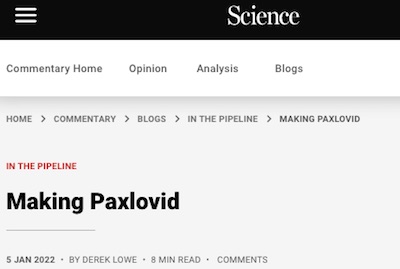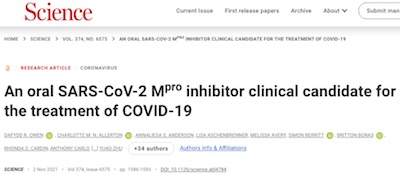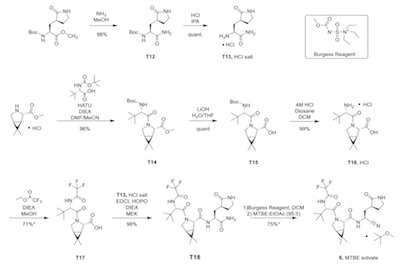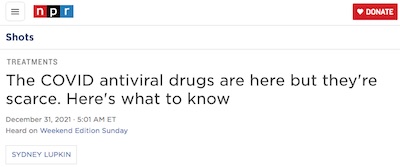Finding paxlovid
Tagged:CatBlogging
/
COVID
/
PharmaAndBiotech
Paxlovid is a remarkable early therapeutic for people who’ve caught COVID-19. But… it’s very scarce for the next few months, ironically during the Omicron wave. Where can you score some paxlovid?!
More supply chain frustration?!
Remember last spring when vaccines were being rolled out? The glacial speed, bungled supply chains, and general chaos? (Not to mention the Republican disinformation campaigns!)
Welcome to the second act: the rollout of antiviral therapies like paxlovid and molnupiravir… with glacial speed, bungled supply chains, and general chaos. (Though so far, the conservative disinformation campaign seems to consist largely of people claiming that paxlovid and molnupiravir are just ivermectin or hydroxychloroquine repackaged at a higher price. The people saying that seem to be utterly fact-proof.)
 Part of the problem is the supply right now is approximately 0, and it’s hard to
manufacture. Derek Lowe, the awesome med-chem blogger at In the Pipeline, offered an
especially well-informed opinion a few days ago on where the bottlenecks
are. [1]
Part of the problem is the supply right now is approximately 0, and it’s hard to
manufacture. Derek Lowe, the awesome med-chem blogger at In the Pipeline, offered an
especially well-informed opinion a few days ago on where the bottlenecks
are. [1]
- Quantity: The dose is two 150mg tablets of nirmatrelvir twice a day for 5 days, and
100mg of ritonavir twice a day for 5 days. That adds up to great, whacking gram-level
quantities of these very complex molecules:
- 150mg nirmatrelvir/pill × 2 pills/dose × 2 doses/day × 5 days = 3 grams of nirmatrelvir per course of treatment!
- 100mg ritonavir/pill × 1 pill/dose × 2 doses/day × 5 days =
1 gram of ritonavir per course of treatment!
So if you want 10 million courses of treatment, you need 30 megagrams = 30,000 kg = 30 metric tons of nirmatrelvir and 20 metric tons of ritonavir. This is… daunting. All that has to be made, then formulated (formed into tablets with appropriate bulk materials), packaged, shipped, delivered to pharmacies/hospitals/clincs… and it all has to be done as soon as possible.
- Synthesis: Metric-ton level synthesis does not happen in funky little laboratories with peculiar bits of glassware all over. It takes a big, noisy, smelly chemical plant. Some of them are special-purpose, making only 1 precursor.
- Chemical supply chain for reagents: There are a lot of inputs, so you won’t make them all yourself. You’ll buy them. Or, at least attempt to buy them. The resulting chemical supply chain involves dozens of factories all over the world.
-
Foreign suppliers: Inevitably, most of the inputs to the process are from overseas, mostly Chinese because apparently that made sense to some MBAs at some point. (NB: Like many scientists, I use “MBA” in its rather more pejorative sense.) The US does not have that kind of capacity any more because of outsourcing, and we can’t build it in less than probably a decade.

 Last year, the paxlovid team published their data, including the synthesis (see
Supplementary Info, package 1, at the end of the article for synthesis of all 6 candidate
molecules). [2] The synthesis shown here (click to embiggen)
is what they had to go through in order to make a measly few hundred grams of
nirmatrelvir for the clinical trial (the ritonavir they could just buy, since it’s
already approved for HIV). Lowe walks us through the whole thing, explaining what the
various steps do (at least, if you’re a synthetic organic chemist, so you can
understand the explanation).
Last year, the paxlovid team published their data, including the synthesis (see
Supplementary Info, package 1, at the end of the article for synthesis of all 6 candidate
molecules). [2] The synthesis shown here (click to embiggen)
is what they had to go through in order to make a measly few hundred grams of
nirmatrelvir for the clinical trial (the ritonavir they could just buy, since it’s
already approved for HIV). Lowe walks us through the whole thing, explaining what the
various steps do (at least, if you’re a synthetic organic chemist, so you can
understand the explanation).Many of the reagents are common, but some are decidedly not: Lowe points out that the Boc-protected t-butylglycine used in T14 is something you can order in gram quantities, but very few suppliers would even attempt to deliver in ton quantities. As always, it turns out that all those putative independent vendors are ordering from 1 guy in China. So… there’s a single point of failure, even if the vendors work hard to conceal it.
Very weirdly, some of the reagents depend for their synthesis on quantities of sodium metal. There’s not enough sodium metal around right now beause the brute-force synthesis requires lots of electricity, which is also in somewhat shorter supply. (Though, if we could shut down the stupid crypto miners, that would be fixable. Do you think people would pause their speculative nonsense in favor of provably life-saving medicine? I don’t either, but then I’m a grumpy old man.)
Lowe’s summary of the chemical synthesis problems for paxlovid:
That’s how it goes in the fine chemical business - there’s a compound that no one really cares much about, until they do and they care hugely, and then suddenly no one cares about it again, until some other bizarre reason emerges to put it back into demand. Multiply that by the thousands of things that are or have been commercially available chemicals at one time or another.
…
What it all means is that when someone says “Oh, we can just make Paxlovid in plants all over the world”, they have left out the rest of the sentence, which is “. . .if we can get the starting materials”. And for now, supply of those starting materials is going to be tight.
So it’s not as simple as just letting other people (try to) build paxlovid plants!
Still… how can I get me some of that stuff?
So that’s one reason why paxlovid is hard to find. It will get better, though not on the timescale by which Omicron gets worse. What can you do in the meantime, if you need paxlovid and want to know how to beat the crowd?
I’m a little conflicted by this: shouldering your way to the front of the line might be good for you, but it’s bad for everybody who’s pushed back. That does real social damage to us as a community. So… conflict.

 From NPR comes an article [3] which mostly points out the
obvious, that paxlovid is in short supply. However, it does perform one very valuable
service: it points us to a US Department of Health & Human Services web site for
finding various COVID-19 therapeutics, the
COVID-19 Public Therapeutic Locator. [4]
From NPR comes an article [3] which mostly points out the
obvious, that paxlovid is in short supply. However, it does perform one very valuable
service: it points us to a US Department of Health & Human Services web site for
finding various COVID-19 therapeutics, the
COVID-19 Public Therapeutic Locator. [4]
It can find paxlovid, molnupiravir, and evusheld for you. (Did you forget evusheld? Remarkably many people do.) Of course, we’re most interested in paxlovid. It can also do a number of visualizations like scatterplots and maps. More interestingly to a grizzled old stats nerd like your humble Weekend Editor, it also supports data downloads for independent analysis.
I think we need to say “well done” to the HHS on this one.
 Ok, your humble Weekend Editor does not (yet) have COVID-19. Nor do the Weekend Editrix
nor the Weekend Publisher. But are we gonna try this thing out anyway? (glares out the
screen at you)
Ok, your humble Weekend Editor does not (yet) have COVID-19. Nor do the Weekend Editrix
nor the Weekend Publisher. But are we gonna try this thing out anyway? (glares out the
screen at you)
Of course we are.
So I imagined the unwelcome scenario where I had to hunt down a way to fill a paxlovid scrip for one of us here at Chez Weekend. (Well, maybe not the cat. He, as you can see here – click to embiggen – is unconcerned about your COVID-19 stuff. It’s a tomcat thing.)
 So I put in the parameters for Château Weekend, hoping (without much hope) to find
paxlovid available somewhere within sailing distance in the Weekend Zeppelin. The
associated filter is shown here (click to embiggen):
So I put in the parameters for Château Weekend, hoping (without much hope) to find
paxlovid available somewhere within sailing distance in the Weekend Zeppelin. The
associated filter is shown here (click to embiggen):
- Set the state to Massachusetts.
- Set the county to Middlesex, Suffolk, Norfolk, or Essex: the Boston-adjacent counties.
- The medication (“Order Label”) is paxlovid.
- The courses available are ≥ 0, i.e., not sold out.
 The result is pretty interesting, shown here (click to embiggen). There are exactly 3
vendors in the extended metro Boston area that have paxlovid in supply (18-20 courses of
treatment available). That’s 58 courses of treatment for about 4.87 million people
(0.000019 courses/person)!
The result is pretty interesting, shown here (click to embiggen). There are exactly 3
vendors in the extended metro Boston area that have paxlovid in supply (18-20 courses of
treatment available). That’s 58 courses of treatment for about 4.87 million people
(0.000019 courses/person)!
Yes, I think that officially qualifies as “hard to find”.
Interestingly, when I first ran this query a couple hours ago researching this article, there were something like a dozen vendors (in just Middlesex and Suffolk counties). So over the course of a couple hours, most of the vendors sold out.
So this is not a complete solution. Empirically, we observe that paxlovid courses of treatment sell out in a matter of minutes. And making it (marginally) easier to find vendors still doesn’t fix the supply problem, it just makes it easier for flash-mobs to dogpile on the few places that have what little stock there is.
Remind you of seeking out vaccine apppointments in March of 2021 yet?
We got work to do.
Addendum 2022-Jan-12: Comparison to the Omicron tsunami
I took a look at the IHME dataset for predictions of the Omicron tsunami (we can’t really call it just a wave any more, right?). The big question is: Will paxlovid become available in time to save us from Omicron? The big answer is: No.
So check out tomorrow’s post for that.
Notes & References
1: D Lowe, “Making Paxlovid”, In the Pipeline blog at Science Translational Medicine, 2022-Jan-05. ↩
2: D Owen, et al., “An oral SARS-CoV-2 Mpro inhibitor clinical candidate for the treatment of COVID-19”, Science 374:6575, 2021-Nov-02. DOI: 10.1126/science.abl4784 ↩
3: S Lupkin, “The COVID antiviral drugs are here but they’re scarce. Here’s what to know”, NPR from Weekend Edition Sunday, 2021-12-31. ↩
4: US Dept of Health & Human Services Office of Chief Data Officer, “COVID-19 Public Therapeutic Locator”, HealthData.gov, retrieved 2022-Jan-11.
NB: When accessing this site with either a phone or tablet, for me it redircted to a completely useless mobile version that could not do filtering. The desktop/laptop version (URL ending in “/data/”) still seems to work fine.↩

Gestae Commentaria
Comments for this post are closed pending repair of the comment system, but the Email/Twitter/Mastodon icons at page-top always work.